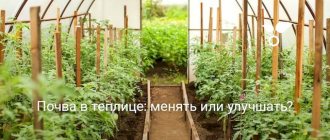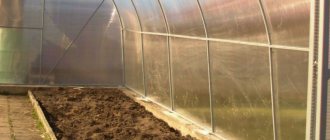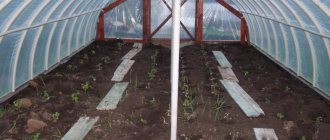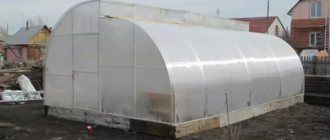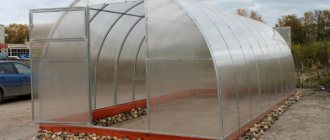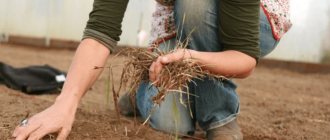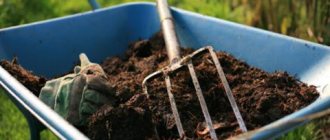Treatment and disinfection of the greenhouse is an important step towards obtaining a good harvest. Capital greenhouses create excellent conditions for the wintering of harmful insects, bacteria, viruses and fungi. In the spring, they attack young plants, preventing them from getting stronger, which leads to partial or complete loss of the harvest.
How to prepare a greenhouse for winter and the next season without harming beneficial insects and the structure itself? Read about it in our article.
Disinfection of a polycarbonate greenhouse in the fall
Content
- Step 1. Cleaning up plant debris
- Step 2. Washing the walls of the greenhouse and equipment
- Step 3. Digging up the greenhouse in the fall
- Step 4. Improving soil composition
- 4.1. Adding compost/vermicompost/humus
- 4.2. Vermiculite
- 4.3. Deoxidation
- Step 5. Application of mineral fertilizers
- Step 6. Disinfection of the greenhouse in the fall
- 6.1. Disinfection of the internal walls of the greenhouse
- 6.2. Treatment of greenhouse soil against phytopathogens
- 5.3 Autumn pest control in the greenhouse
- Step 7. Sowing green manure
- As a conclusion
Processing a greenhouse in the fall is one of the important stages of agrotechnical work. During the season, a lot of effort was spent on fighting late blight, root rot and other fungal and bacterial infections, as well as various insect pests, including soil-dwelling pests. Autumn is the most successful and necessary time for all this work.
In this material we will consider a step-by-step work plan.
Greenhouse treatment in the fall includes:
- Step 1. Cleaning up plant debris;
- Step 2. Washing the walls of the greenhouse and equipment;
- Step 3. Digging (including soil replacement);
- Step 4. Improving the soil composition (adding vermicompost and deoxidation);
- Step 5. Application of mineral fertilizers;
- Step 6. Disinfection (internal walls of the greenhouse with copper-containing preparations, soil treatment against phytopathogenic microflora, soil treatment against soil-dwelling pests, use of smoke bombs, etc.);
- Step 7. Sowing green manure.
And so, in order:
What pests and diseases can overwinter in a greenhouse?
Not all greenhouse inhabitants harm plants. Soil is a living organism; it contains billions of bacteria that constantly work to convert organic matter into chemical compounds that plants consume for growth and development. In addition, the soil is inhabited by worms and insects, and only some of them are dangerous to plants. Do we need to kill everyone outright using strong chemicals?
Recommendations for soil disinfection in a greenhouse
First, you need to figure out what pests and pathogens can survive the winter in a greenhouse and what conditions contribute to this.
Aphids are small insects that feed on plant sap. Aphid colonies can grow rapidly in greenhouse conditions, which leads to damage to young shoots and reduced yield. In addition, aphids secrete a sweetish sticky liquid, creating conditions for the development of fungal diseases.
Aphid
Aphids overwinter in greenhouses and greenhouses in the egg stage, hiding in weeds and unharvested plant debris. In the spring, larvae emerge from the eggs, which soon turn into an adult insect that can cause damage to young plants. In addition, ants hide aphids in their nests - they use this insect as a cash cow, feeding on sweet secretions, and even carry it around the garden in search of new “pastures”.
Ants carry aphids
To eliminate aphids in a greenhouse, it is necessary to carry out thorough pre-winter cleaning of weeds, dead shoots and plant tops. Experienced gardeners also recommend expelling ants from the greenhouse and destroying all anthills built in it.
The whitefly is a flying, sucking insect similar to a moth. Colonies of whiteflies settle on plants and suck the juice from them. The plant gradually withers and dies, the yield is significantly reduced. In a greenhouse, the whitefly can overwinter provided that the temperature does not drop below -5°C; in severe frosts, the pests freeze out.
Whitefly
In the middle zone, to combat whiteflies, it is enough to open the windows in the greenhouse for the winter so that the temperature is equal to the outside temperature. In more southern regions with mild winters, the greenhouse and top layer of soil should be treated with one of the systemic preparations, which will be discussed below.
Spider mites are quite a serious pest that can destroy all the vegetation in a greenhouse in a matter of days. It can be identified by small dots on the backs of leaves and thin, random webs on plants. Spider mites overwinter in crevices of the frame and base of the greenhouse and wood debris. Natural and chemical preparations help against spider mites, but they should be used only after thorough cleaning.
Spider mite
Slugs in greenhouses are also a nuisance to gardeners. The fight against them is also complicated by the fact that they are active only in the dark, so sometimes it is difficult to understand who is eating the shoots and fruits. Slug larvae overwinter in the ground, in the top layer of soil. You can kill them with boiling water or chemicals.
Slug
Nematodes are small parasitic worms that live in the stems, roots or leaves of various vegetable crops. The nematode is a real scourge of greenhouses; it is extremely difficult to remove. Nematodes overwinter in the ground, at a depth of up to 20 cm, or in galls - thickenings on the roots of plants. Stem and leaf nematodes can also overwinter in plant debris.
Nematode - damaged roots
To eliminate nematodes in the garden, crop rotation is most effective. In this case, plants of the same type are returned to their original place no earlier than after 3-4 years. However, in a capital greenhouse this method is unacceptable. Replacing the soil also doesn’t help much, since removing soil to a depth of 20 cm is quite difficult.
To combat nematodes in industrial conditions, potent chemicals are used - systemic nematicides. They are extremely toxic to humans and kill all beneficial microflora in the soil, so they are used with caution in a home greenhouse.
Warming the soil to 50-60°C using hot water, as well as adding organic fertilizers and sugar can be beneficial. At the same time, saprophytes actively begin to multiply in the soil, attracting natural enemies of nematodes.
Strawberry nematode: photo of the pest
Another effective method is to plant plants that inhibit and repel nematodes. These include marigolds and watercress. These cold-resistant plants can be sown immediately after harvesting vegetable crops; in two to three months they will have time to thoroughly clean the soil.
Fungal diseases - late blight, cladosporiosis, fusarium, powdery mildew and various rots - appear in the greenhouse under unfavorable conditions and quickly affect the plants. It is difficult, and sometimes even impossible, to cope with them - most of the crop dies.
Phytophthora is a fungal disease of tomatoes.
Fungi are extremely resistant to external conditions and overwinter well indoors, settling on the soil, greenhouse walls and garden tools. To combat fungi, fungicides and copper-based preparations are used.
Viral and bacterial diseases can be introduced into the greenhouse with soil and planting material, and they are also carried by sucking insects. Therefore, the prevention of viral and bacterial diseases in a greenhouse comes down to cleaning, removing harmful insects and preventive treatment of soil and structures with antibacterial drugs.
Bacteriosis - cucumber disease
Conclusion
Caring for a greenhouse in the fall is not needed to leave it clean and disinfected into winter. This is necessary for the next season in order to minimize the spread of diseases and obtain a harvest for a long time. The more effort you put into your garden in the fall, the fewer problems you will have with the harvest next year. We told you step by step how and with what to treat a polycarbonate greenhouse in the fall to save you time searching for information. Choose any of the proposed drugs and take care of the future gardening season.
Garbage collection
The first stage of work is harvesting the tops.
Harvesting is carried out in early autumn, immediately after harvesting. Aboveground and underground parts of plants are removed, the pins are removed. The collected waste, ropes and wooden stakes are burned. They are not suitable for reuse as they contain a lot of bacteria.
If the tops are free of diseases and pests, they are sent to a compost pit. The furrows are cleared of debris, weeds are pulled out, and the flooring is repaired.
What is late blight?
Late blight is a serious fungal plant disease caused by late blight, a fungus-like protist of the oomycete division. Translating its Latin name Phytophthora, we get the phrase “destroying plants.” And it fully corresponds to the nature of the impact of this pathogen.
On a note! Plants of the Solanaceae family suffer from late blight more than other crops. These are potatoes, tomatoes, capsicums. Strawberries, buckwheat and other representatives of the flora are also susceptible to late blight.
Phytophthora reproduces by zoospores, which easily overwinter on old tubers, tops, other plant debris and even in soil. And as soon as favorable conditions are created, late blight wakes up, becomes active and begins to spread throughout the plants.
It is greenhouse conditions, that is, humid and warm conditions, that are most favorable for the rapid development and subsequent reproduction of this fungus. Phytophthora spores begin to develop on plant foliage at air temperatures above +10 degrees and humidity around 75%.
Genus Phytophthora
By the way, late blight will live not only on plants - it will happily nest for the winter on the greenhouse itself - its covering, frame.
On a note! Spores enter the soil when rain washes them off plant leaves, and infection can also occur with the help of wind - light spores are easily carried by air currents for many kilometers.
Signs of late blight on crops are extremely difficult to identify in the early stages. Moreover, not all plants are affected by the parasite at once.
Signs of late blight on tomatoes
The main signs of crop damage by late blight.
- A whitish coating appears on the reverse side of the leaves, which gradually spreads to the stem and ovaries.
- Gradually, dark areas begin to appear on the plant organs, and brown putrefactive spots begin to appear on the fruits, since late blight is always accompanied by rot.
Late blight is a disease that is not to be trifled with. If you don’t fight it and don’t take preventative measures to protect your favorite garden, then it can cause significant damage to your entire green farm, including your greenhouse.
Important! Dense plantings contribute to the spread of late blight
How to disinfect the soil?
In a greenhouse, soil is constantly and actively used, so residues of fungicides, insecticides, fertilizers and salts accumulate in it. As a result, after just a few years it becomes unsuitable for growing crops - it is now a breeding ground for pests and diseases. In this case, the soil will need to be replaced every few years.
It is necessary to remove a layer whose thickness is 25-30 cm. But before the procedure, you need to get rid of the mulch, if there is any.
If it is not possible to replace the soil in the greenhouse, it is necessary to resuscitate it. To do this, first of all, you need to disinfect the soil with biological products, which will not only destroy dangerous microorganisms, but also improve the health of the soil. Fitosporin-M is suitable for this purpose. They should be applied 14 days before the onset of autumn frosts to a depth of 5-10 cm. Repeat the procedure in the spring.
After this, add 40-50 kg of compost or rotted manure for each m2, and carry out a two-level digging. At the final stage, water the soil with preparations that will help accelerate the decomposition and humification of plant residues.
You can also disinfect greenhouse soil with chemicals, of which there are many and must be selected taking into account what diseases the plants in the structure suffered from. But when using such products you need to be careful and follow safety precautions.
Ready-made chemicals for greenhouse treatment
The list of chemicals is extremely wide, and most of them have a wide spectrum of action. When treating a greenhouse, it is better to choose products with a targeted effect that do not disturb the balance of microorganisms in the soil. Descriptions of the drugs are given in Table 1.
Table 1. Description of insecticides and fungicides for greenhouse treatment.
| Name of the drug | Application |
| Fufanon | The drug is used against aphids, whiteflies, thrips, and spider mites. Dilute the drug in a dosage of 5 ml per 5 liters of water and spray wintering areas of insects (cracks in the frame, fences of ridges), and also spill the top layer of soil. |
| Storm | Effective against slugs and snails. The drug is scattered over the soil surface in a dosage of 15 g per 5 m2 immediately after harvesting the plants. After contact with it, slugs become dehydrated, lose mucus and die. After the onset of cold weather, treatment is useless. |
| Muratsid | Preparation for the destruction of garden ants. Dilute a 1 ml ampoule in 10 liters of water and water the nests at a dosage of 1 liter per nest. As a result, the ants become trapped in the nest and die when trying to get out. Ant trails are also treated with the solution. |
| Thunder | The drug is effective against mole crickets and ants. When mole cricket burrows up to 2 cm in diameter are found on the soil surface, a slightly moistened preparation is placed in them (1 teaspoon per burrow). To kill ants, the drug is sprinkled on the anthill. |
| Marshal | Effective against nematodes, aphids, thrips, spider mites. Dilute a 7 ml ampoule in 7-10 liters of water and spill the soil over 10 m2. You cannot carry out more than one treatment per season! The drug is highly toxic to humans and animals! |
| Fitosporin | Biological product for the treatment and prevention of fungal diseases. Dilute 5 g of powder per 10 liters of water and spray the top layer of soil, walls and ceiling of the greenhouse. Treatment is carried out at a temperature not lower than +10°C; at lower temperatures, the active substances of the drug do not act. |
| Copper sulfate | A preparation for complex treatment of greenhouses against diseases and pests. Dilute 1 tbsp. l. copper sulfate in 10 liters of water, spray the walls and water the soil until moist. |
Note! When processing, you must strictly adhere to the dosage of the selected drug indicated on the packaging, and also follow all safety precautions!
How to fertilize the soil?
After harvesting the soil before the onset of winter, it is necessary to feed it so that it can recover for the next sowing season. The procedure is important especially when tomatoes were grown in a greenhouse. This crop is demanding on the soil, so it takes all the nutrients from it and it loses its fertility.
Nutrient supplements can be bought ready-made, but preparing them yourself is not difficult. For this you will need compost and wood ash. The next layer consists of sand and sawdust. For 1 m2 you need a bucket of manure and peat. Dig up.
Attention!
Using manure can contaminate the area with fungal infections and bacteria. Therefore, immediately after applying such fertilizer, the soil must be watered for disinfection with a solution of copper sulfate. Repeat the procedure in the spring.
In the fall, you need to fertilize the soil in a greenhouse not only with organic fertilizers - you can also add complex mineral fertilizers. In the case when the greenhouse is constantly covered and is not affected by precipitation, it is permissible to apply fertilizers containing potassium and phosphorus in early or mid-autumn. They gradually dissolve in moist soil without being washed out. Therefore, in the spring the plants will receive them in the required quantity.
On average, per 1 m2 you will need 40-60 g of superphosphate, 25-30 g of potassium salt or potassium sulfide.
Stage 4. Fumigation
Proper soil cultivation is not just washing the surface. This is why it is necessary to fumigate the greenhouse. To do this, use checkers of sulfur or cuttings of sulfur.
First, you need to tightly close the windows and doors and carefully caulk the holes. To achieve maximum effect, it is better to wet the structures.
Option #1. Cutting sulfur. It's easy to use. To treat the greenhouse, you should take cuttings of sulfur at the rate of 1 kg per 10 cubic meters of room. It is finely crushed and mixed with coal. The resulting mixture is scattered onto metal baking sheets. They are placed in containers like basins, which are filled to the middle with water. After this, you need to place the containers over the entire area of the room and set fire to the sulfur.
Trademarks of sulfur preparations "Cherenkovaya"
Purified sulfur: piece and powder; cutting sulfur: pieces and powder
Dangerous! When burned, sulfur releases toxic substances that are hazardous to human health. Therefore, this fumigation is allowed only if the respiratory tract, eyesight, etc. are protected. If a gas mask is not available, you can use a respirator, but you must wear special glasses for protection. It is very important to protect your hands by wearing gloves.
Fumigating a greenhouse with sulfur is a dangerous procedure
Option #2. Sulfur checker. It is easy to calculate the amount of the drug: 60 g of checkers are used per cubic meter of room. They are laid out on sheets in the same way as the previous fumigation, after which they are placed around the area of the room and lit.
Sulfur bomb "FAS"
Prices for sulfur smoke bombs
sulfur smoke bomb
Sulfur checker on a plate
Greenhouse manufacturers do not recommend this treatment. Combustion products can damage the metal structures of the greenhouse, so you need to carefully study the instructions, which will indicate whether this method of disinfection can be used. If such disinfection is allowed, but the metal frame is damaged, it is also better not to use sulfur.
Fumigation of a greenhouse with a sulfur bomb
The sulfur will smolder for about 5 days, so during this time it is better not to enter the greenhouse or open it. When the time is up, doors and windows should be opened and the room thoroughly ventilated. It is better to wash polycarbonate surfaces with pemoxol solution using a sprayer. After wiping, you need to spray the surfaces of the greenhouse with clean water from a hose.
Option #3. You can carry out wet disinfection. To do this, you need to prepare a bleach-lime solution, which is sprayed on all surfaces. Of course, before using the solution you should put on a protective suit and a respirator.
Lime bleach
Option number 4. A large number of summer residents prefer to do without sulfur, replacing it with Bordeaux mixture or other remedies against protozoa and insects. Such solutions are sprayed with a spray bottle over the surfaces of the polycarbonate structure.
Components of Bordeaux mixture
Preparation of Bordeaux mixture
Note! If the frame is made of metal, before fumigation with sulfur it must be treated with solid oil - this makes it possible to avoid corrosion.
